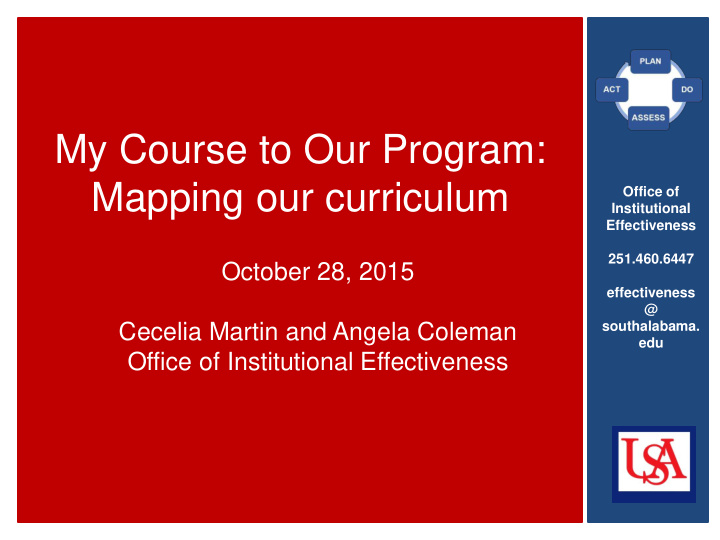



My Course to Our Program: Mapping our curriculum Office of Institutional Effectiveness 251.460.6447 October 28, 2015 effectiveness @ southalabama. Cecelia Martin and Angela Coleman edu Office of Institutional Effectiveness
What is a curriculum map? • Is a visual depiction of a program’s curriculum. • Ensures instruction is aligned with program outcomes. • Identities gaps in the curriculum. • Makes program improvements. • Determines the degree to which there is consistency between: • What faculty expect students to learn. • The learning experiences faculty design. • Assessments of student learning.
Curriculum Map vs. Degree Map • Degree maps help students know the path to graduation: what courses to take and when. • Curriculum maps help faculty ensure they are preparing students to meet expectations for learning that they have determined are fundamental to the discipline for a particular level (Bachelor’s vs. Master’s).
First Step: Program-level Student Learning Outcomes (SLOs) • Developed collaboratively such that all faculty have helped determine… • The SLOs and had opportunity to see where they and their course(s) contribute to the curriculum. • What types of assessments are illustrative of whether student’s have met program -level expectations. • SLO’s should balance internal and external forces… • Based in current practice and/or literature • Aligned with accrediting bodies, professional associations, licensure boards/exams (when appropriate)
Qualities of good SLOs Use Bloom’s Taxonomy to help ensure students demonstrate learning on multiple levels SLOs are SMART!!!!
Second Step: List Program course requirements • Identify all major requirements: those courses required beyond the Alabama core curriculum • What about electives or program requirements where students choose from a menu? (see example)
Second Step: List program course requirements (continued) Of the 13 course listed here, each has its own learning outcomes. However, collectively this requirement (and all the courses represented by it) , should map back to one or more program level learning outcomes.
Map Courses to SLOs: Content Where courses and learning outcomes intersect, indicate what is the level of learning that is expected I = introductory R=Reinforced M=Mastery (this example uses D instead of R)
Map Courses to SLOs: Assessment Determine how faculty will know whether students are meeting program level expectations. • External Assessment – Licensure exam, departmental assessment (e.g., comprehensives, committee review of course assignments) • Course-based assessment – Designed by the program faculty as a whole (type, rubric, etc.) but assigned and graded by the faculty member of record for the course. • Map the course-based assessment on the curriculum map (A=assessed) – Ensure that the type of assessment matches the level of the SLO (e.g., multiple choice tests rarely assess students’ ability to synthesize).
Examples of curriculum maps • Why this works: Informative, no gaps
Examples of curriculum maps (continued) What do you think?
Examples of curriculum maps (continued) What do you think?
Expectations for USA Academic Programs • Complete by October, 2016 • Submit with the October, 2016, assessment plan
Thank you! Office of Institutional Effectiveness 251-460-6447 effectiveness@southalabama.edu
Recommend
More recommend